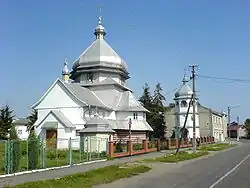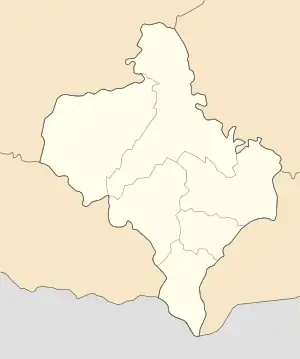Yezupil
Yezupil (Ukrainian: Єзупіль; Polish: Jezupol) is an urban-type settlement in western Ukraine. It is located in Ivano-Frankivsk Raion (district) of Ivano-Frankivsk Oblast (region), approximately 14 kilometres (8.7 mi) north of the administrative center of the oblast, Ivano-Frankivsk. Yezupil hosts the administration of Yezupil settlement hromada, one of the hromadas of Ukraine.[1] Population: 2,753 (2022 estimate).[2]
Yezupil
Єзупіль | |
|---|---|
 Yezupil main road | |
 Coat of arms | |
 Yezupil  Yezupil | |
| Coordinates: 49°02′N 24°47′E | |
| Country | Ukraine |
| Oblast | Ivano-Frankivsk |
| Raion | Ivano-Frankivsk Raion |
| Founded | 1435 |
| urban-type settlement | 1940 |
| Government | |
| • Mayor | Hanna Kushnir |
| Area | |
| • Total | 28.220 km2 (10.896 sq mi) |
| Elevation | 260 m (850 ft) |
| Population (2022) | |
| • Total | 2,753 |
| • Density | 98/km2 (250/sq mi) |
| Postal code | 77411 |
| Area code | +380 3436 |
| Website | Ukrainian Parliament website |
History
Yezupil was previously referred to as part of the Halych Powiat (county). It is also a part of the historic region of Pokuttya in Galicia.
At the turn of the century, town Jezupol (former Zhovten) was a fair size town (with its own Jewish Kahil and Roman Catholic Church and Greek Catholic Church) in Galicia/Halychyna in Austro-Hungarian Empire.
It is approximately 7 km from Halych, the former capital of the Principality of Halych Volhynia in the 10/12th centuries. In 1352 – 1772 it was a part of Ruthenia Voivodeship in the Kingdom of Poland. First mentioned in 1435 as Cheshybisy (Polish: Czesybiesy[3]), up until the 16th century it was a village with a wooden fortress. When the fort was destroyed during one of the Tatar incursions, Jakub Potocki, the voivode of Wroclaw and private owner of the town, renamed it Jesupol, after Jesus in 1597. In 1598, a fortress and Dominican monastery was erected, and the town developed next to it. The monastery had a rich and famous library of ancient scriptures and prints.
Upon the partition of the Polish–Lithuanian Commonwealth in 1772 the Kingdom of Galicia and Lodomeria, or simply Galicia, became the largest, most populous, and northernmost province of the Austrian Empire, where it remained until the dissolution of Austria-Hungary at the end of World War I.
In the prelude to the Second World War, the Molotov–Ribbentrop pact divided Poland roughly along the Curzon line. Thus, all territory east of the San, Bug and Neman rivers were annexed into the USSR, approximating the former territory of East Galicia. This territory was divided into four administrative districts (oblasts): Lvov, Stanislav, Drohobych and Tarnopol (the latter including parts of Volhynia) of the Ukrainian Soviet Socialist Republic. Since September 17, 1939, it was a part of the USSR. Since June 22, 1941, the Soviet regime discontinued when Germany had occupied East Galicia during Operation Barbarossa.
In 1945, the town became a part of the Ukrainian SSR as part of the Soviet Union; since 1991, the town has been a part of Ukraine. The first Jezupil (Jesupol) named town was renamed to Zhovten (Ukrainian: Жовтень); it received the status of an urban-type settlement in 1940. On July 9, 2003, the town was officially renamed again to Jezupil.
Until 18 July 2020, Yezupil belonged tp Tysmenytsia Raion. The raion was abolished in July 2020 as part of the administrative reform of Ukraine, which reduced the number of raions of Ivano-Frankivsk Oblast to six. The area of Tysmenytsia Raion was merged into Ivano-Frankivsk Raion.[4][5]
Notes
- "Езупольская громада" (in Russian). Портал об'єднаних громад України.
- Чисельність наявного населення України на 1 січня 2022 [Number of Present Population of Ukraine, as of January 1, 2022] (PDF) (in Ukrainian and English). Kyiv: State Statistics Service of Ukraine. Archived (PDF) from the original on July 4, 2022.
- Czołowski 1890, p. 7.
- "Про утворення та ліквідацію районів. Постанова Верховної Ради України № 807-ІХ". Голос України (in Ukrainian). July 18, 2020. Retrieved October 3, 2020.
- "Нові райони: карти + склад" (in Ukrainian). Міністерство розвитку громад та територій України.
References
- Czołowski, Aleksander (1890), Z przeszłości Jezupola i okolic, Lwów
{{citation}}: CS1 maint: location missing publisher (link)